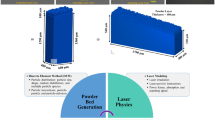Abstract
Additive manufacturing (AM) technologies provide a method of fabrication that minimizes the production of waste and maximizes part customization. The most common form of this technology is material extrusion (ME) in which material is deposited layer-by-layer to produce a highly customized part. However, this additive production method has experienced difficulty in widespread adoption in metal fabrication due to the inability to produce metallic parts with strong mechanical properties. This study presents some innovations on a new metal-fabrication technique for ME printing that allows for low-cost metal printing. A metal powder polymer composite filament, with a high metal composition, can be printed and sintered to yield a part that is completely metal. Overall, this study provides the initial investigation of the microstructural behavior and the resulting hardness levels. This study found that the metal powder in finished parts is fused by approximately 90% derived from the percent area porosity on a microstructural level. The final hardness of the processed parts is reduced by approximately 60%. Characterizing these properties is the initial step in incorporating ME technology in the field of metal 3D printing.








Similar content being viewed by others
References
Wohlers T (2019) Wohlers report 2019: 3D printing and additive manufacturing state of the industry. Wohlers Associates
Comb J, Priedeman WR, Turley PW (1994) FDM technology process improvements. Proc. Solid Free. Fabr. Symp., pp 42–49
Liang Q-J, Li XD (2018) Application of FDM additive manufacturing technology in making medical surgical model. DEStech Trans. Eng. Technol. Res., no. ecame, pp 133–137
Böckin D, Tillman A-M (2019) Environmental assessment of additive manufacturing in the automotive industry. J Clean Prod 226:977–987
Wu P, Wang J, Wang X (2016) Automation in Construction A critical review of the use of 3-D printing in the construction industry material Finished. Autom Constr 68:21–31
Bos F, Wolfs R, Ahmed Z, Salet T (2016) Additive manufacturing of concrete in construction: potentials and challenges of 3D concrete printing. Virtual Phys Prototyp 11(3):209–225
Prater T, Werkheiser MJ, Ledbetter F, Morgan K (2018) In-space manufacturing at NASA Marshall Space Flight Center: a portfolio of fabrication and recycling technology development for the international space station. In: 2018 AIAA Sp. Astronaut. Forum Expo., p 5364
Riecker S, Clouse J, Studnitzky T, Andersen O, Kieback B (2016) Fused deposition modeling – opportunities for cheap metal AM. World PM2016-AM-Deposition Technologies
Gong H, Snelling D, Kardel K, Carrano A (2019) Comparison of stainless steel 316L parts made by FDM- and SLM-based additive manufacturing processes. JOM 71(3):880–885
SpaceX (2014) SPACEX launches 3D-printed part to space, creates printed engine chamber. Retrieved 28 Apr 2016
Landau E (2014) Printing the metals of the future. NASA, Pasadena
EOS (2020) EOS systems. https://www.eos.info/systems_solutions/metal/systems_equipment(online)
Frazier WE (2014) Metal additive manufacturing: a review. J Mater Eng Perform 23(6):1917–1928
Kuan AY, Hoe-lian D, Rebecca P, Web RP (2016) Metal 3D printing via selective laser melting and direct metal deposition: materials, properties and applications. Prog. Addit. Manuf.
Watson J, Vondra H, Fidan I (2018) The development of a framework for 3D printing, casting, and entrepreneurship. In: 2017 ASEE Annual Conference & Exposition Proceedings
Fresques T, Cantrell D, Fidan I (2015) The development of a framework between the 3D printed patterns and sand-cast work pieces. Int J Rapid Manuf 5(2):170
Duda T, Raghavan LV (2016) 3D metal printing technology. IFAC 49(29):103–110
Hwang S, Reyes EI, Sik Moon K, Rumpf RC, Kim NS (2015) Thermo-mechanical characterization of metal/polymer composite filaments and printing parameter study for fused deposition modeling in the 3D printing process. J Electron Mater 44(3):771–777
L. The Virtual Foundry (2019) The virtual foundry. https://www.thevirtualfoundry.com. Accessed 07 Jul 2019 (online)
Terry S, Fidan I, Tantawi K (2019) Dimensional analysis of metal powder infused filament—low cost metal 3D printing. Solid Free. Fabr. Symp. Proc.
Terry SM (2019) Innovating the fused filament fabrication process metal powder polylactic acid printing. ProQuest Diss. Publ.
ASTM Standard E18 (2015) Standard test methods for rockwell hardness of metallic materials. ASTM International, West Conshohocken, PA, pp 1-38
Acknowledgements
This study has been made available through funding by NSF Award 1801120, Smart Manufacturing for America’s Revolutionizing Technological Transformation; and NSF Award 1601587, AM-WATCH: Additive Manufacturing—Workforce Advancement Training Coalition and Hub. Editing support provided by Dr. Elizabeth Powell of the Clay N. Hixson Student Success Center and Ms. Amy Hill of the Research Office is greatly appreciated.
Author information
Authors and Affiliations
Corresponding author
Rights and permissions
About this article
Cite this article
Terry, S., Fidan, I. & Tantawi, K. Preliminary investigation into metal-material extrusion. Prog Addit Manuf 6, 133–141 (2021). https://doi.org/10.1007/s40964-020-00151-5
Received:
Accepted:
Published:
Issue Date:
DOI: https://doi.org/10.1007/s40964-020-00151-5




